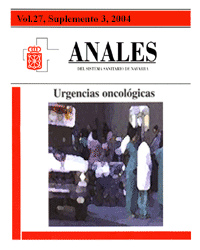Tratamiento del dolor en el paciente oncológico
Palabras clave:
Dolor. Escalera analgésica. Opiáceos.Resumen
El dolor es un síntoma de alta prevalencia en los pacientes con cáncer y deteriora de forma importante su calidad de vida. Con las medidas enunciadas por la OMS en 1986, que divide en tres escalones ascendentes las distintas opciones terapéuticas de las que disponemos, el dolor puede ser controlado en un alto porcentaje de casos. Aquellos pacientes difíciles de controlar con estas medidas, se pueden beneficiar de la aplicación de técnicas de neuromodulación por expertos en el tratamiento del dolor crónico. El correcto manejo de los distintos fármacos (AINES, opiáceos y coadyuvantes), el conocimiento de sus efectos secundarios, la pérdida del miedo a los opiáceos y el conocimiento de los distintos síndromes álgicos asociados al paciente oncológico, deben ir de la mano con la adecuada valoración del dolor según las distintas escalas, tanto en la fase de instauración del tratamiento, como en el seguimiento del paciente.Descargas
Descargas
Publicado
Cómo citar
Número
Sección
Licencia
La revista Anales del Sistema Sanitario de Navarra es publicada por el Departamento de Salud del Gobierno de Navarra (España), quien conserva los derechos patrimoniales (copyright ) sobre el artículo publicado y favorece y permite la difusión del mismo bajo licencia Creative Commons Reconocimiento-CompartirIgual 4.0 Internacional (CC BY-SA 4.0). Esta licencia permite copiar, usar, difundir, transmitir y exponer públicamente el artículo, siempre que siempre que se cite la autoría y la publicación inicial en Anales del Sistema Sanitario de Navarra, y se distinga la existencia de esta licencia de uso.








